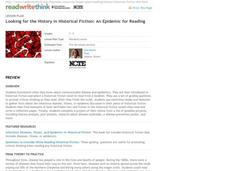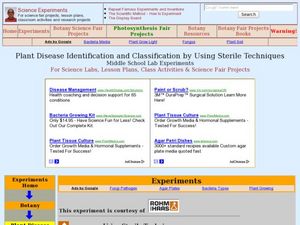Curated OER
How to be a Healthy Person
Young scholars discuss their health and diseases. In this health lesson, students discover the causes of diseases and the difference between infectious and non-infectious diseases. They find ways to boost their immune system.
Creative Learning Exchange
The Infection Game: The Shape of Change
Encourage the spread of knowledge in your class with this cross-curricular epidemic simulation. Pulling together science, social studies, and math, this instructional activity engages students in modeling the spread of infectious...
ReadWriteThink
Looking for the History in Historical Fiction: An Epidemic for Reading
Combine informational reading skills with fictional text in an innovative historical fiction lessons. After reading a fictional text related to diseases, class members read non-fictional text to gain knowledge about specific infectious...
Teach Engineering
Processes on Complex Networks
Introduces your class to random processes in networks with an activity that uses information about disease spread using the susceptible, infectious, resistant (SIR) model. Participants determine whether a susceptible person becomes...
Curated OER
Plant Disease Identification and Classification by Using Sterile Techniques
Seventh graders identify how to use sterile techniques when identifying plant pathogens. In this plant diseases lesson students complete a lab activity in which they see how plant diseases are identified and classified.
Curated OER
Using Sterile Techniques as a Tool in Studying Plant Diseases
Seventh graders examine the concept of sterile techniques. They realize that plant diseases can be identified and classified in various way. Students identify some of the diseases that attack the garden plants.
Teach Engineering
Curb the Epidemic!
Class members use an applet on the Internet to simulate the spread of a disease. The simulation allows individuals to determine two nodes to vaccinate to limit the number of nodes infected. By running several simulations, scholars can...
Howard Hughes Medical Institute
Viral Lysis and Budding
How do some viruses spread so quickly, and why do they make us feel terrible? Answer these (and many more) questions through a simple yet impactful lessons. Pupils observe demonstrations that show the two methods viruses use to escape...
Curated OER
Superbugs: An Evolving Concern
Students investigate the growth of bacteria in the presence of antibiotics. They write a hypothesis, conduct an experiment to test their hypothesis, analyze the results of their bacterial growth experiment, and describe the results on a...
CK-12 Foundation
Ck 12: Life Science: 11.59 Noninfectious Diseases
Explore some non-infectious diseases and how to prevent them.
Khan Academy
Khan Academy: Treatment of Malaria
After malaria has been confirmed by lab or biochemical diagnosis, treatment must begin immediately. But first the type of Plasmodium causing the infection, whether the patient has severe or non-severe infection, and if the parasite is...












